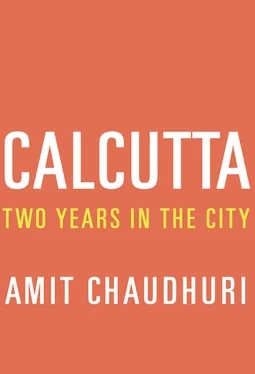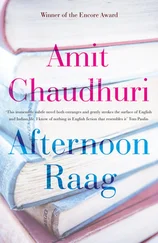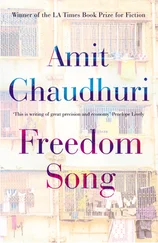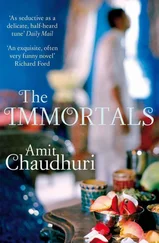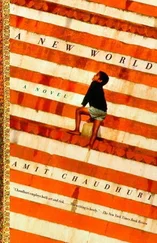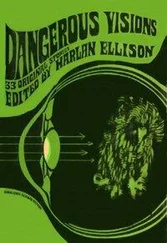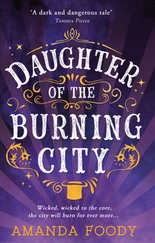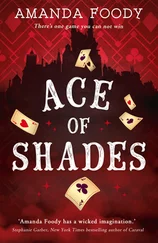For me, the principal emblem of Christmas in Calcutta is neither Santa, nor the nativity, nor the Cross, but the Christmas tree. Almost no one in Calcutta has seen a real one. It enters certain spaces — the middle-class living room; the showroom and shop; the cafe — but it’s we who, with its seasonal proximity, are travelling inadvertently towards the faraway. With its fake, shiny bristles, it represents a journey. It’s also a reminder that the faraway can be manufactured — perhaps is always manufactured. No one misses the actual Christmas tree; to eventually see one is not so much a disappointment as a matter of slight puzzlement. I saw real Christmas trees again recently, being sold on a pavement in the Angel in London, unloaded from a truck, arranged, and covered in gauze, so that they resembled, somewhat, the inert botanical figures in Invasion of the Body Snatchers . I was fascinated by them, but received no final illumination, as they seemed a bit off the point; as Christmas outside of Calcutta seems generally. Once you’ve experienced a genuine transplantation (a genuine fake, as it were, an offshoot that takes on its own life), you lose, strangely, your appetite for, and your capacity to recognise, the original. This might explain, from more than four decades of living memory, the historical radiance of the Christmas trees of New Market.
What do people in this city, now that it’s neither moored to its past nor part of a definite future, do as the new year approaches? They celebrate; they eat out. The rich and well-to-do have an internal map (mostly of avenues and lanes in South Calcutta) of houses and parties they must visit or avoid; or they’ll romp in a club, dancing on a lawn to a band as the old year dies out. Others go to Park Street.
This New Year has probably been around in Bengal for two hundred years. The Bengali new year, which might be more than a millennium old, is the first day of the month of Baishakh, in early summer, usually the 14th of April, give or take a day for the variations in the almanac. Once, the New Year must have been a curiosity, a strange, amusing diversion to be smiled at, neither comfortably of this place nor to be wholly ignored (what was this thing?); but now it’s the Bengali new year that’s become ceremonial and arcane, part of a continuity that’s even more make-believe than Christmas. On the first day of Baishakh, at least some men dress up for a day as “Bengalis,” wearing the intricately pleated cotton dhuti that was, even until the sixties, the most elegant attire a Bengali man could be seen in, horribly difficult, like the sari, to master, but worn always with a suggestion of casualness. Such were the contraries of the bhadralok.
My wife, who works as a scholar on the nineteenth century, has pointed out a poem to me called “Ingraji Naba Barsha”— “The English New Year”—by the (she thinks underrated) poet Iswar Gupta. It first appeared in 1852, a time just preceding the tumultuous change of 1857 (when the Sepoy Mutiny led to colonial power passing from the East India Company to the Crown, and formalised the Raj), and is canny and mildly satirical; R reminds me it’s also deeply attentive to the real, in the way it captures that occasion with the urgency of a bulletin. Iswar Gupta was a tremendously popular poet in his time — perhaps the Bengali poet — but, after the preponderance of the new bhadralok humanism from the 1860s onward, after the ascendancy of the “new” Calcutta (which, one hundred and fifty years later, is old, ruined, maybe even dead), he was no longer deemed a serious poet, and then ignored and forgotten. Iswar Gupta is not a poet of “emotion recollected in tranquillity,” as Tagore, at certain moments, might seem to be.
Bankimchandra Chatterjee, the first Bengali novelist, called him “jaha achhe tahar kobi,” or the “poet of what’s at hand” (for his subjects included pineapples and goats); my wife, echoing D. H. Lawrence, says he’s a “poet of the present.” Iswar Gupta is not a poet of memory, or the personal or historical perspective; but that doesn’t mean he’s ahistorical. History is not the annals; it’s what happens around us when we’re unaware it’s history. It’s Gupta’s unawareness of himself, his subjects, or of Calcutta as something separate called “history,” in a static, retrospective sense, that makes them all bustle with it. As a poet, he has recourse to devices common to traditional Bengali poetry — such as onomatopoeia — that later poets would use temperately, if at all, in a more Sanskrit-derived, literary manner, but which he employs shamelessly and with a radical outrageousness, as a response to the odd transitory society he inhabits. R writes that, in “ Ingraji Naba Barsha ,” the poet “initially describes a white man … joyous and indulgent, well-dressed in his well-decorated home. At his side, his wife looks ‘fresh’ in a ‘polka-dotted dress’ (‘ maanmode bibi shab hoilen fresh/Feather- er folorish phutikata dress’).” The English words dropped liberally in the two lines—“fresh,” “feather,” “dress”—aren’t really comparable to the comfortable melange-like contemporary chatter of the globalised Indian middle class; they’re used in the way the lower classes traditionally use English — to pepper a sentence; to mutter a jocular barb; to pass a sexual insult about an upper-class woman. Midway into the poem, “the poet imagines himself to be a fly accompanying these two”—the Englishman and his polka-dotted wife—“on their carriage to church” (all these churches still exist mysteriously in different parts of the city), “sometimes sipping from their glass of sherry, sometimes sitting on her gown or her face and happily rubbing its wings.” In what incarnation but that of a pest would the man on the street partake of the slopes of a memsahib’s breasts? For Iswar Gupta, at this point, “poet” and “pest” seem interchangeable. The next scene describes the astonishing dinner back at the Englishman’s house, “evoked almost entirely and only through sound”:
Very best sherry taste merry rest jaté
Aage bhage den giya srimatir haaté
Kot kot kotakot tok tok tok
Thhun thhun thhun thhun dhok dhok dhok
Chupu chupu chup chup chop chop chop
Shupu shupu shup shup shop shop shop
Thhokash thhokash thhok phosh phosh phosh
Kosh kosh tosh tosh ghosh ghosh ghosh
Hip hip hurré daké whole class
Dear madam you take this glass .
As R points out, this doesn’t, largely, need translating, “except the framing couplets, of which the first one says that the very best sherry that makes the rest merry is to be given to the missus before anybody else, while the one at the end is almost entirely in English except for the word daké , which means calls.” A great deal of movement and physical activity is captured from that New Year’s Day— “Kot kot kotakot tok tok tok” probably the sound of heels ascending the steps and then authoritatively hitting the floor of the drawing room; “thhun thhun thhun” the pitch of the cutlery; “dhok dhok dhok” the sound ascribed usually to the rapid drinking of water, but here, almost certainly, of alcohol. The particular shape and form of these sounds were still unexpected to the Bengali ear. The terse, consonantal sound of English is also probably being alluded to, and mocked. Indians who didn’t and don’t know English, and want to mimic the way it’s spoken, make brief plosive noises: “phat,” “phoot,” “phut.” So there’s a belligerence to Iswar Gupta’s poem, the petulance of the poet/pest; it bubbles with resentment and energy.
Читать дальше
